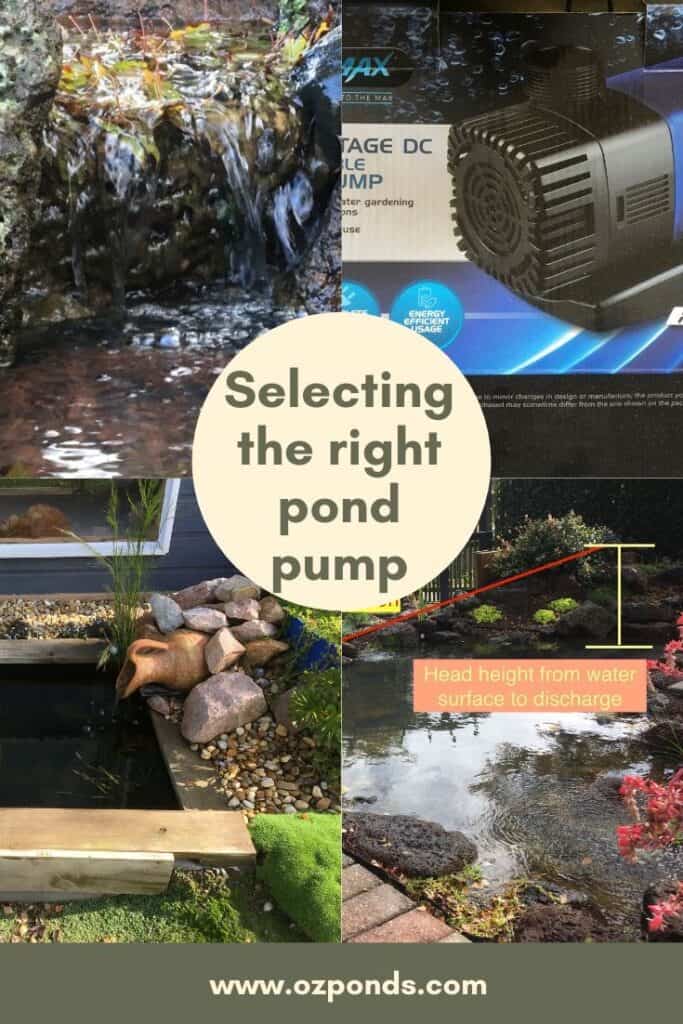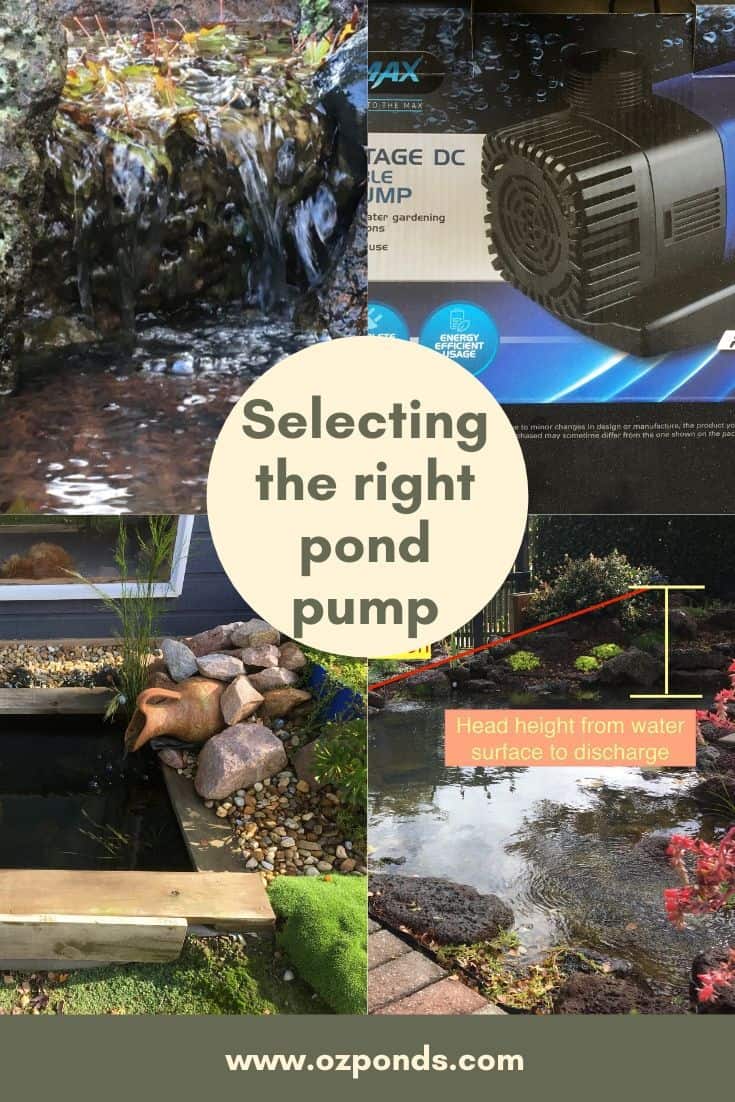To select the right pond pump these are the questions you’ll need to ask and answer.
- How much water you need to circulate?
- How high does the water need to be pumped?
- How far does the water need to be pumped?
- Do you want to have a waterfall? If so how wide?
- How efficient are the available pumps?
- Do you have access to a nearby power source?
This article will point you in the right direction to selecting the perfect pond pump for your application.
Below is a table showing a quick guide for recommended flow rates for different sized ponds.
These rates are based on a 60cm deep pond, with water being pumped through a biological filter.
| Pond size | 250 litre pond | 500 litre pond | 1,000 litre pond | 2,000 litre pond | 5,000 litre pond | 7,500 litre pond | 10,000 litre pond |
| Pond with no fish | 150 litres/ Hr | 300 litres/ Hr | 600 litres/ Hr | 1,200 litres/ Hr | 3,000 litres/ Hr | 4,500 litres/ Hr | 6,000 litres/ Hr |
| Pond with fish | 300 litres/ Hr | 600 litres/ Hr | 1,200 litres/ Hr | 2,400 litres/ Hr | 6,000 litres/ Hr | 9,000 litres/ Hr | 12,000 litres/ Hr |
The table below shows a quick guide for recommended flow rates for different sized streams and waterfalls.
To create a decent looking waterfall/ stream requires quite a lot more flow than a pond.
| Stream/ Waterfall | 25cm wide | 50cm wide | 75cm wide | 1m wide |
| Babbling brook | 3,250 litres/ Hr | 6,500 litres/ Hr | 9,750 litres/ Hr | 13,000 litres/ Hr |
| Moderate flow/ sound | 4,875 litres/ Hr | 9,750 litres/ Hr | 14,625 litres/ Hr | 19,500 litres/ Hr |
| White water/ lots of noise | 6,500 litres/ Hr | 13,000 litres/ Hr | 19,500 litres/ Hr | 26,000 litres/ Hr |
Water Circulation
How often the water in a pond is circulated is an important thing you should consider when selecting a pond pump.
Water circulation will greatly affect the quality and health of the water.
Ponds that have inadequate circulation are more prone to algae outbreaks and will require much more maintenance.
As a general rule we should strive to turn the water over least once per hour, especially in fish ponds.
This will help keep pond temperature stable (reducing algae) but more importantly it allows water to be constantly flowing over surfaces that have micro-organisms and beneficial bacteria.
These micro-organisms and bacteria are the most important part of any pond ecosystem.
They break down waste and nutrients keeping the pond water safe for fish and crystal clear.
Good bacteria and micro-organisms form the backbone of what’s known as the nitrogen cycle.
I don’t want to delve to much into the nitrogen cycle in this article but it is something that every pond owner should have a basic understanding about.
You can click this link to read a guide i wrote on the nitrogen cycle in a pond.
Understand this and keeping a pond is simple! Nature does all the work and you kick back and enjoy 🙂
So now you have an idea why circulation is important the next step is finding pond pumps that will circulate your pond adequately.
You’ll need to know how much water your pond holds. If you’re not sure how to calculate this check out my article on how to calculate pond area and volume.
Factors that effect water flow
The two factors that will affect the flow of a pond pump are head height and pipe friction.
As water is pumped upwards the amount of flow diminishes.
Also as the water is pumped through a pipe over distance it loses flow due to friction.
Head height
All pond pumps will have a chart or diagram showing how the pump performs at different head heights.
This is simply the height from the waters surface to where the water discharges.
As you can see on the picture graphic below the flow of the pump decreases as the head height increases.
This is very important to pay attention to!
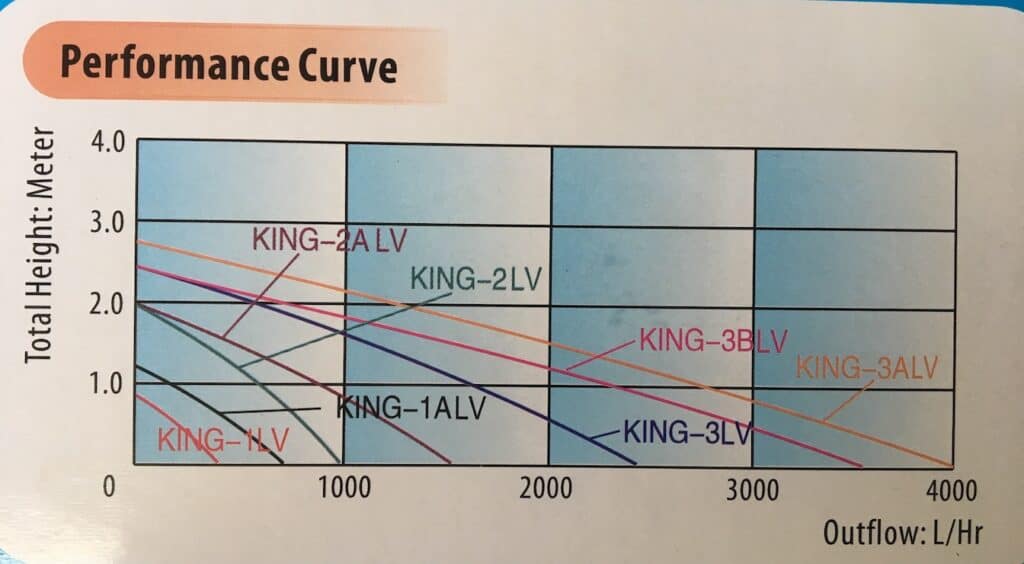
Use the performance chart to select the right pump.
Pipe friction
The other factor that effects head height and that is the friction in the pipe that delivers the water wherever its going- Stream, waterfall, filter etc.
As the water is pumped through the piping there is a certain amount of resistance. This resistance will have an effect of the amount of water the pump can move, therefore directly impacting on the overall head height.
The general rule used to calculate how much pipe friction adds to the head height is 10cm for every metre of pipe.
Every 1 meter of pipe length is equal to an extra 10cm of water lift or head height.
For example: if we were pumping water from a pond up to a stream/waterfall and it requires 5m of pipe to reach the beginning of the stream. This would add 50cm of head height.
So if the start of the stream is 1m above the waterline. The overall head height required is 1.5m.
Water lift + pipe friction = overall head height.
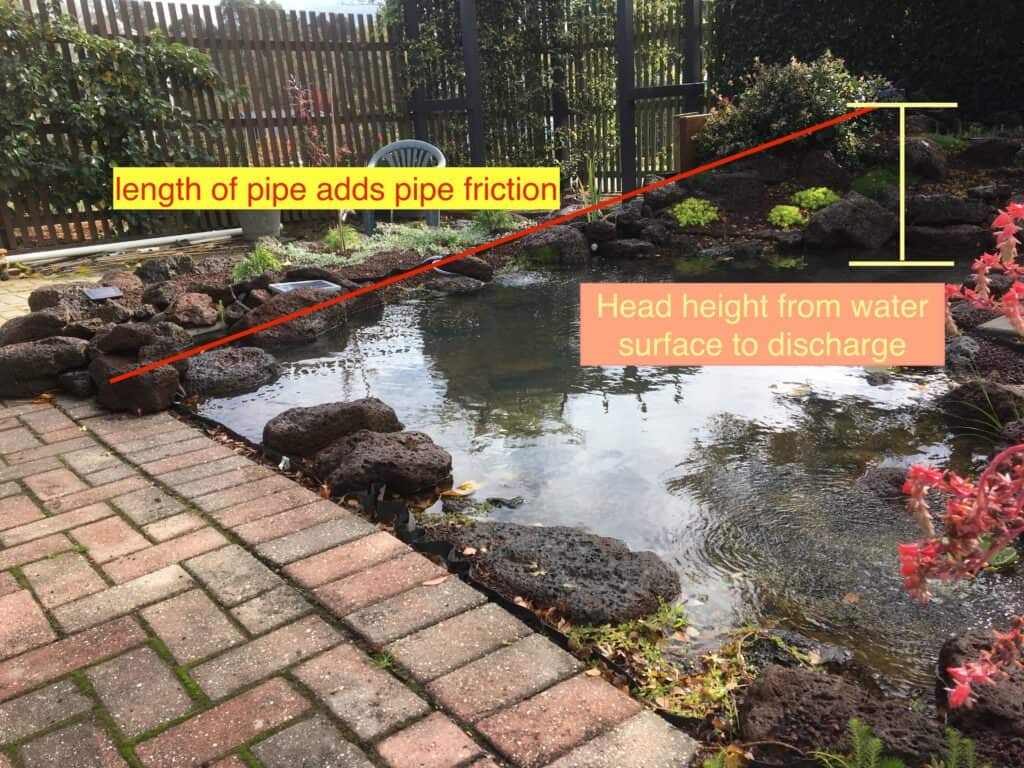
Why head height is important?
The head height is important to understand because it will determine the amount of water the pump will produce. In almost every pump there will be some kind of water lift and/or pipe friction to account for.
For example if i have a pond that is 3000 Litres and i want to have a waterfall that is 50cm high. To move the water from the pump to the waterfall i need 3m of pipe. This means my head height is 50cm (Waterfall) + 30cm (Pipe friction) = 80cm (Overall Head height)
The curved line on the back of the pump will tell me what the pump is capable of pumping at a head height of 80cm. If this is 3000L or more then the pump is suitable for my pond and waterfall.
If i simply went out and purchased a pump that produces 3000L/ per hr and added my pipe and waterfall the pond would not be circulating once every hour which should always be our goal.
Remember that if the water isn’t circulating often enough you’ll have potential problems with water quality, health and clarity.
So always, always figure out what the overall head height you need is, and consult the specs provided on the pond pump box!
Waterfalls and stream
If you plan on adding a waterfall or stream to the pond you’ll need to ensure there is enough flow to create a decent waterfall, or enough water thickness so the water covers the rocks in the stream.
So here is the general rule to follow.
A 25cm wide stream or waterfall will require a pump flow of 3250 litres per hour.
50cm wide would require a flow of 6500 litres per hour.
So basically for every 5cm of stream or waterfall width you need 650 litres of flow.
This will provide a good amount of water. Theres nothing worse than spending all that money and time building a waterfall and steam and having a trickle.
Been there done that 🙁
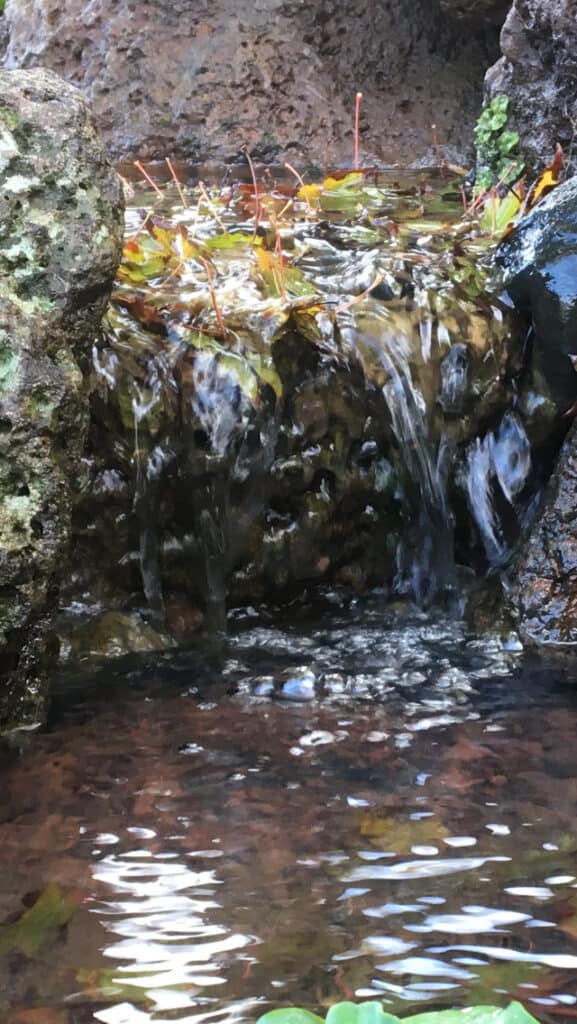
Energy efficiency
Once you understand the pumping requirements for your pond, its easy to compare different models of pumps and find the most efficient model.
When looking for pond efficiency the one thing you need to look at is watts! How many watts the pump will use.
A
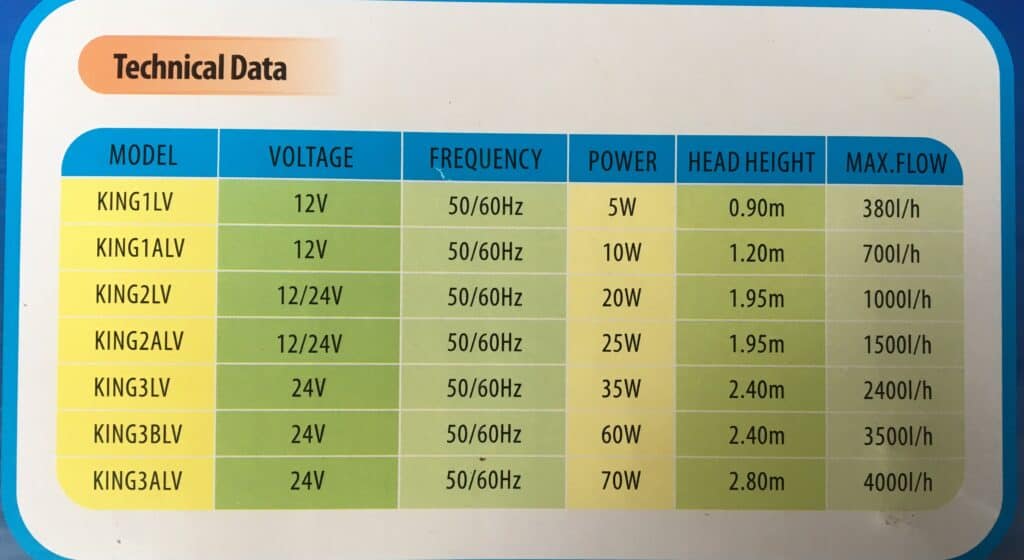
We pay for electricity by the kilowatt hour, so the less watts our pump uses the more it will save our hip pocket.
When you’re comparing the pumps keep your head height in mind. You’ll be amazed at how different the consumption of electricity can be between pumps that pump the same amount of water.
Heres an example:
The hozelock cascade 1500 Low volt pond consumes 35 Watts per hour. At a head height of 1m it delivers 900L/ per hour. At time of writing i found this pump for $162.
A Pond max EV1910-DC low volt pump consumes 13 Watts per hour. At a head height of 1m it delivers 900L/ per hour. At time of writing i found this pump for $ 209.
I Have used both brands and have been really happy with both. But as you can see the difference in watts used is quite striking.
Cost to Run vs Cost to Buy
Most often the more energy efficient pumps will cost more to purchase. Using the two pumps cited in the above example, let’s work out how much they will cost to run and how long it will take to recover the difference.
To keep it simple let’s say we pay 25c per kilowatt hour for electricity. Now let’s work out how much each pump costs per day. There’s 1000 watts in one kilowatt so we can divide the watts by 1000 to get the kWh number.
So the hozelock will be 0.035 kWh and the pond max 0.017 kWh.
First I multiply the watts by 24 (hours in a day) so for the hozelock pump that will look like this:
0.035(kWh) X 24 = 0.84 (kW) per day
0.84 X .25 (cost of a kWh) = 0.21c per day to run.
0.21c X 365 (days in a year) = $76.65 per year to run
Now for the Pond max let’s do the same:
0.013 (kWh) X 24 = 0.312 (kW) per day
0.312 X .25 (cost of a (kWh) = 0.078c per day to run.
0.078c X 365 (days in a year) = $28.47 per year to run.
So the hozelock pump cost $162 to buy and the Pond max pump was $209. The difference is $47.
The difference between each pump per year is $76.65 (hozelock) – $28.47 (Pond max) = $48.18.
Therefore in one year the costs are recovered if we purchase the pond max. Both pumps had a 2 year warranty, so in this particular example the pond max would be the better buy.
Doing these simple calculations is always a worthwhile endeavour when comparing different pumps.
Electricity to the pond
Hiring an electrician to put in an outdoor electrical outlet can be expensive. At time of writing most electricians charge about $80 per hour.
To save some money you can dig the trench from the house to the pond yourself. You’ll still need the electrician to connect all the wires and provide a compliance certificate,
A lot of well known pump brands will come with a 5-10m long cable. But often this just isn’t long enough.
You should never use a normal household extension lead to extend this cord!
Pumps come in 2 types of voltage. Normal 240V and low volt 12 or 24 volts. Most normal 240 volt pumps will require an outdoor power socket.
Low volt pumps can be safely extended by the DIY’er. This is because they use a transformer that will convert the 240V down to 12 or 24 Volts. This is a much safer voltage.
With good quality low volt cabling a 24volt pump can be extended up to 70m before there’s a drop in voltage. What this means is you’re able to run the cable yourself up to 70m from the socket the transformer is plugged into.
I find this incredibly handy and most of my pond pumps are 24 Volt!
The downside is that generally the low volt model will be more expensive to purchase than a 240V model.
240 Volts will give you more options to choose from while the Low volt pumps give you the ability to do everything yourself without an electrician.
The choice is yours, but certainly something to be aware of when selecting your pond pump.
So those are the 3 things i look when making a pond pump selection. Hopefully that will help you to do the same.
Subscribe
I love saving my readers money! From time to time suppliers and distributors reach out to me and offer special deals and discounts to my readers.
If you would like to receive these offers be sure to subscribe to my mailing list.
